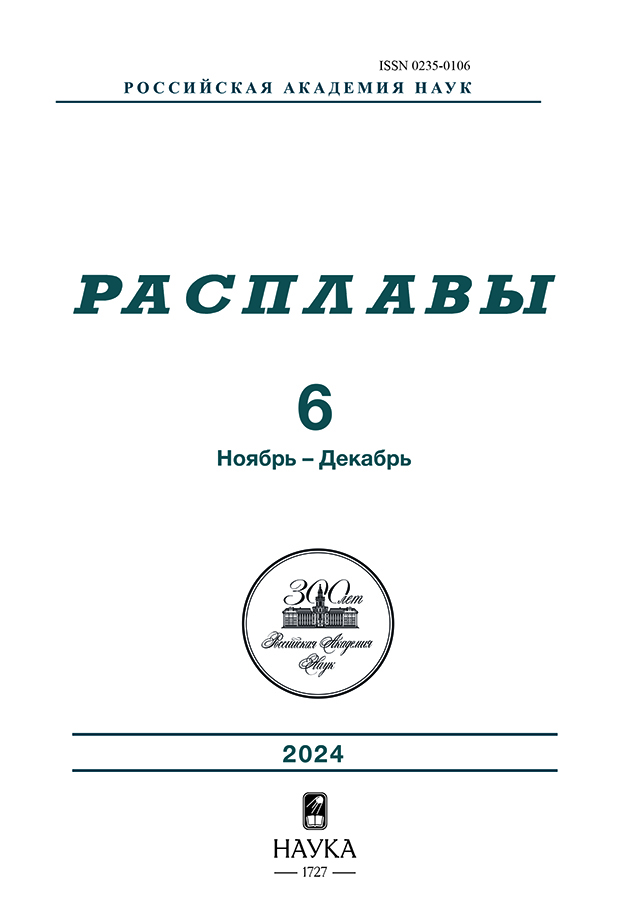Corrosion of EP-823 STEEL (16Kh12MVSFBR) under conditions of high-temperature processing of spent nuclear fuel
- 作者: Karfidov E.A.1, Nikitina E.V.1, Mazannikov M.V.1, Potapov A.M.1, Dedyukhin A.E.1
-
隶属关系:
- Institute of High-Temperature Electrochemistry, Ural Branch of the RAS
- 期: 编号 6 (2024)
- 页面: 581-595
- 栏目: Articles
- URL: https://rjmseer.com/0235-0106/article/view/661954
- DOI: https://doi.org/10.31857/S0235010624060014
- ID: 661954
如何引用文章
详细
The corrosion behavior of EP-823 steel was studied during high-temperature treatment (HTT) with nitrogen. It was found that in nitrogen at temperatures of 650–800°C, the steel is subject to only slight surface corrosion. It is shown that there is a slight change in the surface composition and structure of steel, which does not have a significant effect on the reprocessing of model SNF. It is shown that on the surface of the material, processes of interaction of some electronegative components of ferritic-martensitic steel with components of the gas phase – nitrogen and impurity oxygen – occur with the formation of inclusions of nitride and oxide compounds of chromium and manganese of different stoichiometric compositions. The process is limited by the diffusion of these components from the volume of the alloy to the surface. The corrosion rates of EP-823 steel at temperatures of 650 and 800 ° C were 0.104 and 0.241 mm / year for 12 hours of exposure, and 0.013 and 0.02 mm/year for 84 hours of exposure, respectively. The nature of the destruction of the surface of the samples is continuous and uneven, localization of corrosion at the boundaries of steel grains is clearly observed, which is associated with the formation of secondary phases along the grain boundaries. At the temperature of the treatment, significant sensitization of steel occurs, chain-like precipitation of secondary phases is observed along the grain boundaries, which leads to the development of intercrystalline corrosion. Conclusions are made about the change in the structure of the material during high-temperature exposure and the nature of the corrosion damage of the material is determined; based on the results of X-ray fluorescence analysis, conclusions are made about the composition of the corrosion products of EP-823 steel.
全文:
作者简介
E. Karfidov
Institute of High-Temperature Electrochemistry, Ural Branch of the RAS
编辑信件的主要联系方式.
Email: neekeetina@mail.ru
俄罗斯联邦, Yekaterinburg
E. Nikitina
Institute of High-Temperature Electrochemistry, Ural Branch of the RAS
Email: neekeetina@mail.ru
俄罗斯联邦, Yekaterinburg
M. Mazannikov
Institute of High-Temperature Electrochemistry, Ural Branch of the RAS
Email: neekeetina@mail.ru
俄罗斯联邦, Yekaterinburg
A. Potapov
Institute of High-Temperature Electrochemistry, Ural Branch of the RAS
Email: neekeetina@mail.ru
俄罗斯联邦, Yekaterinburg
A. Dedyukhin
Institute of High-Temperature Electrochemistry, Ural Branch of the RAS
Email: neekeetina@mail.ru
俄罗斯联邦, Yekaterinburg
参考
- Ozeryanaya I.N., Zalazinsky G.G., Smirnov M.V., Finkelstein S.D., Shamanova N.D. Korroziya molibdena v rasplavlennom khloride natriya v prisutstvii ugleroda [Corrosion of molybdenum in molten sodium chloride in the presence of carbon] // Zashchita metallov. 1975. № 1. P. 66-68. [In Russian].
- Kuznetsov V.A., Yalunina G.V. Osnovy metrologii [Fundamentals of metrology]. M.: IMK Izdatel’stvo standartov, 2001. [In Russian].
- GOST R 8.736-2011. Gosudarstvennaya sistema obespecheniya yedinstva izmereniy. Izmereniya pryamyye mnogokratnyye. Metody obrabotki rezul’tatov izmereniy. Osnovnyye polozheniya [State system for ensuring the uniformity of measurements. Direct multiple measurements. Methods of processing measurement results. Basic Provisions], 2011. [In Russian].
- Borisov V.M., Trofimov V.N., Kuz’menko V.A., Sapozhkov A.Yu., Mikhailov V.B., Yakushkin A.A., Cherkovets V.E. Laser plasma methods for improving the corrosion resistance of EP-823 steel fuel-element cladding at 650–720°C // Atomic Energy. 2017. 121. № 5. P. 344–349.
- Semenova I.V. Florianovich G.M., Khoroshilov A.V. Korroziya i zashchita ot korrozii [Corrosion and corrosion protection]. Moscow: FIZMATLIT, 2002. [In Russian].
- Ulig G.G., Revi U.U. Korroziya i bor’ba s ney. Vvedeniye v korrozionnuyu nauku i tekhniku [Corrosion and its control. Introduction to corrosion science and technology]. M.: Khimiya, 1988. [In Russian].
- Rosenfeld I. L. Korroziya i zashchita metallov [Corrosion and protection of metals] M.: Metallurgiya, 1970. [In Russian].
- Zhuk N. P. Kurs teorii korrozii i zashchity metallov [Course in the theory of corrosion and protection of metals: Textbook. Manual] M.: Metallurgiya, 1976. [In Russian].
- Sukhotin A. M. Fizicheskaya khimiya passiviruyushchikh plenok na zheleze [Physical chemistry of passivating films on iron]. Leningrad: Khimiya, 1989. [In Russian].
- Kolotyrkin Ya. M. Metall i korroziya [Metal and corrosion]. M.: Metallurgiya, 1985. [In Russian].
- Remy G. Kurs neorganicheskoy khimii [Course in inorganic chemistry], Vol. 2. M.: Mir, 1963. [In Russian].
- Devine T. M. Mechanism of intergranular corrosion and pitting corrosion of austenitic and duplex 308 stainless steel // J. Electrochem. Soc. 1979. 126. № 3. P. 374-385.
- Korolev M.L. Azot kak legiruyushchiy element stali [Nitrogen as an alloying element of steel]. M.: GNTI, 1961. [In Russian].
- Samsonov G.V. et al. Analiz tugoplavkikh soyedineniy [Analysis of refractory compounds]. M, 1962. [In Russian].
补充文件



















